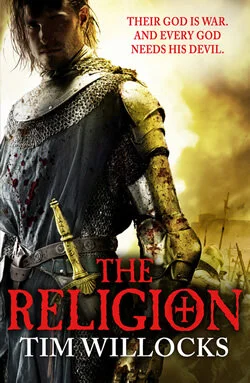Reading Willocks' The Religion, Ten Years On
The edition of The Religion that I bought off the spinner rack.
This latest Jotunish assault on Midgard prompted me to think back upon the last time the Sons of Ymir stalked about Essi-Keh with such ferocity. That would’ve been late January of 2011, when I had just settled in here at the ancestral Homestead. Two blizzards hit within the space of ten days. Subzero temperatures and lots of snow. The roads were impassable in the aftermath of the first snowstorm. Being an independent man of leisure at that point, I rode out the initial arctic blast, sheltering in place and burning rick after rick of the holy Osage Orange.
Then the second polar onslaught arrived. I’d had enough. As soon as the roads had been plowed, I called up the girlfriend—fifteen miles away—and suggested I come over for an extended stay. She was quite amenable. I shoveled about one hundred feet of driveway through three-foot drifts…but I made it out. Cabin fever is real, sword-brothers.
Once ensconsed within the warmth of my significant other's domicile, I had to find a way to pass the time while she was at work. I'd been hitting Dollar General's paperback spinner rack pretty regularly for months at that point, picking up Hard Case Crime novels with McGinnis and Orbik covers. This time, I hit the frikkin' jackpot.
There on the spinner rack was a copy of Tim Willocks' The Religion for a dollar. Having heard good things--sometimes almost unbelievably positive things--from various people about Willocks' novel, I decided I couldn't lose at that price. Buying The Religion was easily one of the best dollars I ever spent.
I hate to say it, but I almost looked forward to my gf being gone for much of the next two days. The eight hundred pages of Willocks' epic transported me from snowbound Essi-Keh to Sicily and Malta during the portentous summer of 1565. Cataclysmic hand-to-hand combat, volcanic passions and smoldering intrigue poured forth from the pages of that marked-down paperback. I was hooked, a fan for life.
Tim Willocks
I've written about Tim Willocks and The Religion on the DMR Blog before, here and here and here. I'm still not quite comfortable writing a full-blown review of it. I believe in writing book reviews right after (re-) reading the novel in question. I haven't reread The Religion in its entirety for about three years. Also, just as importantly, The Religion isn't just any novel. In my opinion, it is the best/most 'important' novel written so far in the twenty-first century. Any review from myself needs to measure up to that self-imposed ranking and I don't think I'm quite there yet.
What I can do is look at some of the objections/complaints/critiques I've seen out there on the Interwebz. That way, when I do get around to a proper review, I can simply link back to this post rather than side-tracking the review.
Firstly, I've seen questions about the name of the novel itself. 'The Religion' references the name used among the Order of Knights of the Hospital of Saint John of Jerusalem--commonly known as the Knights Hospitaller--to refer to themselves. This usage was derived from the original Latin and basically meant 'those who are bound to a common code' or somesuch. 'The Brotherhood' would broadly capture the meaning in English. Nothing more and nothing less.
Secondly, I keep seeing references to Tannhauser--the protagonist of the novel--being some sort of 'Mary Sue' or 'Gary Stu'. Here's one from a female reader:
'He knows how everything should be defended, he is looked to grudgingly for his experience in the Muslim world, he turns the loins of women to water and the hearts to [sic] men to envy.'
Admittedly, Tannhauser is a highly-competent/lethal alpha male along the lines of Conan the Cimmerian. Such men have always existed and the reactions she deplores are pretty standard. Navy SEALS have no problem finding wives or male admirers. The ‘loins of women’ she refers to number exactly two. Willocks does inject Tannhauser into the deliberations of the Knights--but that is obviously for narrative purposes and the novel would be lessened if Tannhauser was a mere 'grunt' fighting on the battlements with no greater knowledge of the big picture.
Tannhauser is far from 'perfect'. Psychologically, he is quite damaged from his previous experiences. What might make him seem 'perfect' to modern eyes is that he doesn't wave the bloody flag of his traumas about for all to see. Tannhauser is nobody's 'victim'. Some other reviewer tried to say that Tannhauser 'always knew what was going to happen' or somesuch tripe. If so, many of the events in the novel never would've come to pass. Accusations like that are just ridiculous.
Another bitchy complaint is in regard to the amount of gore in the novel. Let me state this plainly: The Great Siege of Malta was one of the bloodiest battles ever fought in the history of mankind. Much of the bloodshed was wreaked hand-to-hand. What is 'too much gore' in that context? Willocks is a doctor who worked in trauma wards. Perhaps his depictions of combat 'in the round' are simply too much for some delicate souls.
The final complaint I'll deal with is that the novel is 'too sexual' or that it reads like 'a trashy romance novel' or that the two main female characters are somehow 'shallow' or 'weak'. The depictions of sexuality in The Religion is in no way out of proportion to its depictions of violence. Willocks does not narrate Tannhauser's every act of coitus any more than he does so for every combat in the months-long battle that was the Great Siege of Malta. Every sexual scene has a purpose within the narrative.
In regard to the two main female characters in The Religion, I have no problem nominating Lady Carla as the strongest woman character in twenty-first century literature. What she went through before the novel takes place and then what she becomes by the end of the tale should be studied and pondered. Most 'feminist' stories these days consist of some female physically kicking the asses of various men, despite all the laws of physics. Lady Carla earns the heart-felt, profound respect of every male defender of Malta whilst never raising a hand in anger. These are men who have seen it all, who have stared Death in the face time and again. Every single one of them would lay down their lives for Carla.
Amparo is Carla's friend and the archetypal 'mystic innocent'. I, personally, have known women like her, so when I see reviewers whine about how 'shallow' or 'unrealistic' she is, I just shake my head. Perhaps much of the animus directed at this novel comes from the fact that the reviewers have only known very average people. That would explain a lot.
Speaking of which...my informal, unscientific canvassing of reviews for The Religion reveals that one-fourth to one-third of those reviews are by women. It would appear that about half--or more!--of those reviews are quite positive. They must not have gotten the memo.
For all of the DMR Blog readers who don't give a damn about memos and who do crave adventure delivered with no holds barred, I recommend The Religion by Tim Willocks. Ten years after I first read it, The Religion still speaks to me in a language filled with brutal beauty and beautiful brutality.
Until I finally get around to writing my own review, here are some I especially like:
The Religion, review by Mario Piva



